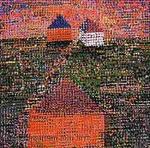Jennifer Bartlett
Jennifer Bartlett
Place: Long Beach
Born: 1941
Death: 2022
Biography:
Jennifer Losch Bartlett is an American artist. She is known for paintings and prints that combine the system-based aesthetic of Conceptual art with the painterly approach of Neo-expressionism. Many of her pieces are executed on small, square, enamel-coated steel plates that are combined in grid formations to create very large works.
Bartlett was born Jennifer Losch in 1941 in Long Beach, California, one of four children. Her father owned a construction company and her mother was a fashion illustrator who left the field to raise her children. She grew up in the suburbs of Long Beach, close enough to the ocean that she developed an affinity for water which would reappear in her mature work. She attended Mills College in Oakland, California, graduating with a BA in 1963. She then moved to New Haven to study at the Yale School of Art and Architecture at a time when Minimalism was the dominant style. She studied with Josef Albers, Jack Tworkov, Jim Dine, and Richard Serra, receiving her MFA in 1965.
Bartlett has described the experience of study at Yale as her broadest influence: "I'd walked into my life". In a 2005 interview with the sculptor Elizabeth Murray (a friend from her Mills College days), she gave this list of things that she said had been on her mind as a first-year art student:
Among Bartlett’s early influences were the painter Arshile Gorky, whose drawing she admired, Piet Mondrian, for the sense of stillness in the work, and Sol LeWitt, for his conceptual systematics.
After marrying medical student Ed Bartlett in 1964, she commuted between the Soho district of New York and New Haven, where she taught at the University of Connecticut. Following her 1972 divorce, Bartlett moved to New York full-time and began teaching at the School of Visual Arts. In 1983 she married German actor Mathieu Carrière, with whom she had a daughter, Alice; they divorced in the early 1990s.
Bartlett is best known for her paintings and prints in which familiar subjects — ranging from houses and gardens to oceans and skies — are executed in a style that combines elements of both representational and abstract art; indeed, she has commented that she does not accept a distinction between figurative and abstract art. She often works in serial form or creates polyptychs, and she frequently devises rule systems that guide the variations within a given group of works, requiring us to focus on "perception, on process, on the effect of shifting perspective— and on the leaps that take place in our minds no matter how rational we may think we are". In the late 1960s, influenced by the work of John Cage, she started bringing chance elements into her work.
Her realistic works favor mundane subjects, such as modest houses. Her installations often consist of multiple canvases as well as three dimensional objects. House with Open Door from 1988, in the collection of the Honolulu Museum of Art, consists of an oil paint on canvas diptych and the same house constructed out of wood. The Dallas Museum of Art, the Honolulu Museum of Art, the Los Angeles County Museum of Art, the Metropolitan Museum of Art, the Museum of Fine Arts, Houston, the Museum of Modern Art (New York City), the Philadelphia Museum of Art, the San Francisco Museum of Modern Art, the Tate Modern, and the Whitney Museum of American Art (New York City) are among the public collections holding work by Jennifer Bartlett
Most critics see Bartlett's work as inventive, energetic, wide-ranging, and ambitious, and she has been called one of the two best painters of the Postminimalism generation. One writer has noted that a central paradox of her work is that Bartlett has taken the controlled, rationalist grid favored by Conceptual artists and used it to release an evocative torrent of imagery that has much in common with the Neo-expressionist work of the 1980s and that owes a debt to Impressionism as well. A few critics find her work shallow, overly focused on surface, and weakened by its eclecticism. She has had several retrospectives and survey exhibitions, the first in 1985 originating at the Brooklyn Museum (New York) and more recent ones in 2011 at the Museum of Modern Art (New York) and 2014 at the Parrish Art Museum (New York).
Early on, Bartlett made a number of three-dimensional works that she subjected to extreme conditions such as freezing and smashing. She also realized that she wanted something to draw on that was erasable but gridded like the graph paper that she and many other Conceptual artists were using at the time. She came up with what is now one of her signature materials: foot-square steel plates with a plain white baked enamel surface on which was silkscreened a quarter-inch grid. She had these fabricated in large quantities, and later worked with other sizes as well.
With her earliest well-known work, Rhapsody, Bartlett reinvented the mural form for Conceptual art. Rhapsody is a painting executed on 987 foot-square enamel-coated steel tiles arranged in a grid 7 plates tall by roughly 142 wide, extending across multiple walls. The subject matter consists of variations on what Bartlett felt were the basic elements of art: four universal motifs (house, tree ocean, mountain), geometric forms (line, circle, triangle, square), and color (25 shades). The seven sections are entitled "Introduction", "Mountain", "Line", "House", "Tree", "Shape", and "Ocean".
More...
Wikipedia link: Click Here














